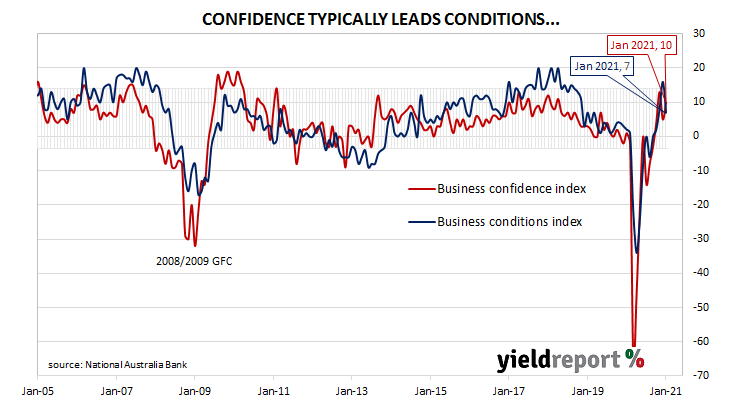Summary: Business conditions deteriorate but confidence improves in January; divergence in conditions across industries; components of conditions index remain above average; capacity usage rate increases again; jobless rate “could fall quite quickly in 2021”, but end of JobKeeper will be “test”.
NAB’s business survey indicated Australian business conditions were robust in the first half of 2018, with a cyclical-peak reached in April of that year. Readings from NAB’s indices then began to slip, declining to below-average levels by the end of 2018. Forecasts of a slowdown in the domestic economy began to emerge in the first half of 2019 and the indices trended lower, hitting a nadir in April 2020 as pandemic restrictions were introduced. Conditions have improved markedly since then.
According to NAB’s latest monthly business survey of over 400 firms conducted over the second half of January, business conditions deteriorated after four consecutive months of improvement. NAB’s conditions index registered 7 in January, down from December’s revised reading of 16.
“The divergence in conditions across industries continues to track as expected, with retail and wholesale still strong, but recreation and personal services continuing to lag,” said NAB chief economist Alan Oster.
“All three components of conditions – trading, profitability and employment – declined, but importantly, they remain above average,” said ANZ senior economist Catherine Birch.
Business confidence improved and NAB’s confidence index rose from December’s revised reading of +5 to +10. Typically, NAB’s confidence index leads the conditions index by approximately one month, although some divergences have appeared in the past from time to time.
“Overall in trend terms, recreation and personal continue to lag the other industries, while retail and wholesale are most optimistic,” said NAB’s Oster.

Longer-term Commonwealth Government bond yields fell on the day, outpacing lower US Treasury yield movements overnight. By the end of the day, the 10-year ACGB yield had lost 4bps to 1.28% while the 20-year yield shed 4bps to 1.95%. The 3-year yield remained unchanged at 0.18%.

